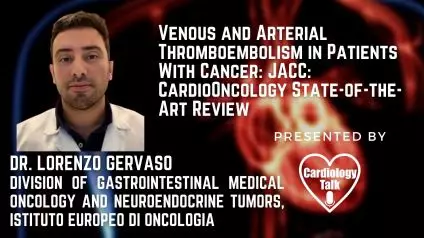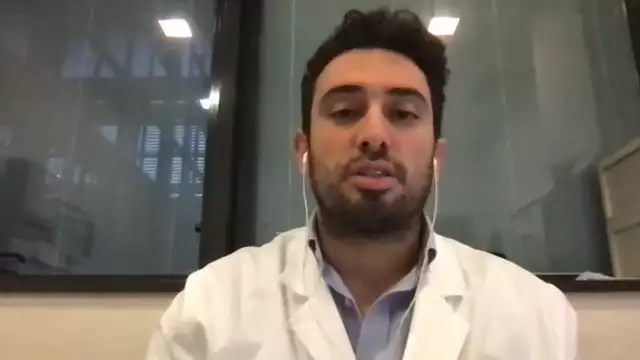Dr. Lorenzo Gervaso- Venous and Arterial Thromboembolism in Patients With Cancer: JACC: CardioOncology State-of-the-A...
Dr. Lorenzo Gervaso works in the Division of Gastrointestinal Medical Oncology and Neuroendocrnine Tumors at the European Institute of Oncology in Milan Italy. In this video Dr. Gervaso discusses Venous and Arterial Thromboembolism in Patients With Cancer.
Link to Abstract-
https://www.jacc.org/doi/10.1016/j.jaccao.2021.03.001
Abstract
In cancer patients, venous thromboembolism (VTE), which includes deep vein thrombosis and pulmonary embolism, is a leading cause of morbidity and mortality. Myocardial infarction and stroke are common complications of arterial thromboembolism. Subgroups of people are more at risk, with greater rates of cancers such pancreatic, stomach, and multiple myeloma. Most patients with active cancer who are hospitalized for medical reasons or who have significant cancer surgery should receive thromboprophylaxis. Outpatient thromboprophylaxis is not usually suggested, but new evidence suggests that a high-risk population that may benefit from pharmaceutical thromboprophylaxis could be identified with the use of a validated risk tool. Direct oral anticoagulants are becoming the preferred new therapeutic choice for cancer-related VTE, however low-molecular-weight heparin remains the gold standard for patients with a high risk of bleeding. Management of VTE after the first six months, as well as difficult clinical conditions such as cerebral metastases and thrombocytopenia, necessitates careful consideration of the advantages and dangers of anticoagulation, and there are significant knowledge gaps in the data.
Highlights
• Patients with cancer are more likely to develop VTE and ATE, which can have serious implications, including death.
• RAMs that include clinical and biochemical characteristics can identify individuals who are at high risk.
• If a patient is diagnosed as having a high risk of VTE, thromboprophylaxis should be investigated.
• DOACs are a newer therapy option for acute VTE, however LMWH is still the gold standard.
• There is a scarcity of information on how to handle ATE in cancer patients.
• Currently, a multidisciplinary strategy involving an oncologist and a cardiologist is advised.
Introduction and Epidemiology
The link between malignancy and a clinical hypercoagulable condition has been intensively explored since it was first identified by Professor Armand Trousseau in the early nineteenth century (1), and it remains a critical public health issue for cancer patients. Thromboembolic events, such as venous thromboembolism (VTE) and arterial thromboembolism, continue to be a major concern for patients with active cancer (ATE). VTE, which includes deep venous thrombosis (DVT) and pulmonary embolism (PE), is more prevalent and can develop at any time during a cancer patient's history, and may even be the disease's first symptom (2). VTE can make surgery, hospitalizations, and systemic therapy more difficult, and it's linked to a significant increase in health-care resource consumption as compared to cancer patients who don't have VTE (3). ATEs, such as myocardial infarction (MI), cerebrovascular events (CVA), and peripheral artery disease, are important causes of death and disability around the world (4). Malignancies are not an established independent risk factor for ATE, despite the well-known changes in clotting function (5). Thromboembolism, which includes both VTE and ATE, is the second-leading cause of death in cancer patients, after the illness itself, and the incidence of thromboembolism can disrupt or delay crucial cancer treatments (6,7).
VTE rates in cancer patients are 4- to 7-fold higher than in healthy people (8), and they appear to be rising in recent years as a result of improved patient survival, more thrombogenic cancer treatments, widespread use of central catheters, and increased awareness of cancer-associated thrombosis (CAT) (9). Several clinical studies have revealed that ATEs are prevalent in cancer patients (10,11), and a prospective analysis of cancer patients undergoing outpatient chemotherapy found that arterial thrombosis was responsible for 5.6 percent of deaths (6).
The hazard ratio (HR) for VTE was 4.7 (95 percent confidence interval [CI]: 4.5 to 4.9) in a UK study comparing cancer patients to matched noncancer control people from the general population, and the incidence rate was 13.9/1,000 per year (95 percent CI: 13.4 to 14.4). (12). According to a recent study, VTE affects about 15% of cancer patients, and 20% of spontaneous VTEs represent the first indicator of an underlying malignancy (13). Navi et al. (14), who used the Surveillance, Epidemiology, and End Results (SEER) database to analyze 279,719 cancer patients (breast, lung, prostate, colorectal, bladder, pancreatic, gastric, and non-Hodgkin lymphoma) and matched them with controls between 2002 and 2011, looked at the incidence of ATE according to cancer subtypes and settings. At 6 months, the incidence of ATE was 4.7 percent in all cancer patients compared to 2.2 percent in the matched control group, however the study sample was largely older cancer patients in the United States. As a result, extrapolating the findings to other populations should be done with caution.
VTE in cancer isn't just about DVT and PE anymore, with reports of thrombosis in odd places such the upper extremities, cerebral veins, and splanchnic veins on the rise (15). With active malignancy, upper extremity thrombosis is 18 times more likely, usually due to the presence of a central venous catheter (13). Splanchnic or visceral vein thrombosis (VVT) is frequently linked to cancer, particularly specific types of gastrointestinal (GI) cancers (16). The majority of these abnormalities are detected by chance during routine surveillance or restaging scans, and their impact on prognosis and outcomes is unknown (17). ATE, on the other hand, is most commonly manifested as MI and CVA, which are far from innocuous due to their severe clinical impact.
In both the prevention and treatment of CAT, a paradigm change has occurred in recent years. New evidence suggests that individuals who take straight oral anticoagulants benefit (DOACs). For both primary and secondary prevention of thromboembolism, large trials focused on cancer populations have been undertaken. The recommended approach for both primary prevention and treatment has recently been modified by guidelines from various societies, including the American Society of Clinical Oncology (ASCO), International Society on Thrombosis and Haemostasis (ISTH), International Initiative on Thrombosis and Cancer, European Society of Medical Oncology (ESMO), National Comprehensive Cancer Network, and American Society of Hematology (ASH) (18–22).
We examine these new findings in the context of risk assessment, prevention, and treatment of both venous and arterial CAT in this review. Throughout, we looked for current data with the highest level of evidence; if it wasn't accessible, we determined that the data was derived from lower levels of evidence.




